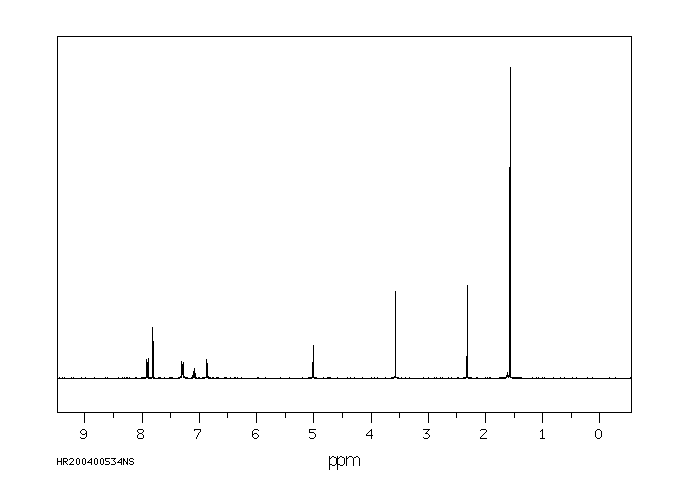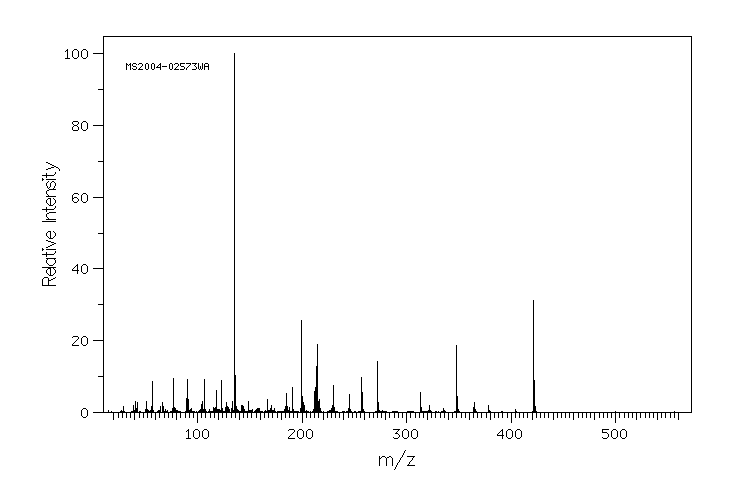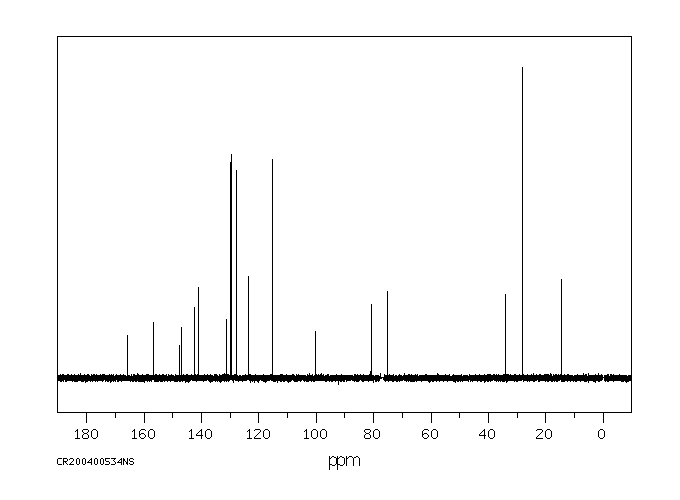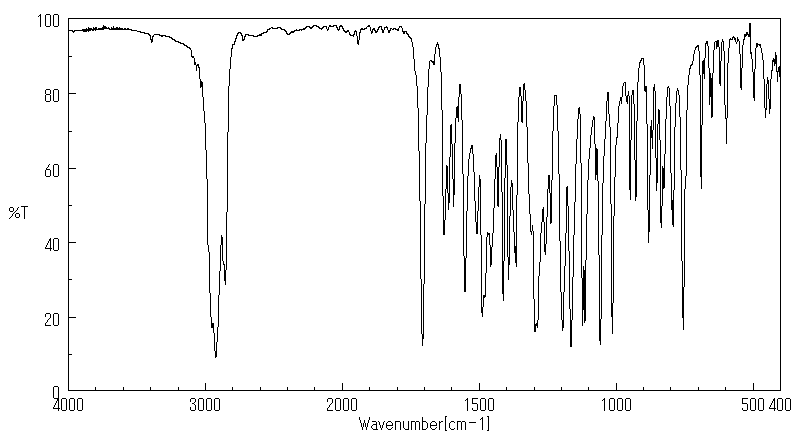唑螨酯 | 134098-61-6
-
物化性质
-
计算性质
-
ADMET
-
安全信息
-
SDS
-
制备方法与用途
-
上下游信息
-
文献信息
-
表征谱图
-
同类化合物
-
相关功能分类
-
相关结构分类
物化性质
-
熔点:101.1-102.4°
-
沸点:546.2±60.0 °C(Predicted)
-
密度:1.25g/cm3
-
溶解度:氯仿:微溶,甲醇:微溶
-
LogP:6.443 (est)
-
颜色/状态:White crystalline powder
-
闪点:85.0 °C (185 °F) (closed cup). /FujiMite 5EC Miticide/Insecticide/
-
蒸汽压力:7.4X10-3 mPa /5.58X10-8 mm Hg/ at 25 °C
-
稳定性/保质期:
对兔皮肤和眼睛有一定的轻度刺激作用。
计算性质
-
辛醇/水分配系数(LogP):4.9
-
重原子数:31
-
可旋转键数:9
-
环数:3.0
-
sp3杂化的碳原子比例:0.29
-
拓扑面积:74.9
-
氢给体数:0
-
氢受体数:6
ADMET
安全信息
-
海关编码:2942000000
-
安全说明:S26,S36/37/39
-
危险品标志:N,Xn
-
危险类别码:R36/37/38,R20
-
危险品运输编号:UN 3077 9/PG 3
-
包装等级:III
-
危险类别:6.1
-
WGK Germany:3
制备方法与用途
除螨剂概述
唑螨酯是一种高效的除螨剂,对农作物上的虫卵、若螨、幼螨和成螨均有效。它能快速解决螨类的危害。唑螨酯存在E体和Z体两种异构体,其中E体的杀螨活性较高,杀螨速度更快。高剂量时可直接杀死螨类,低剂量时则抑制螨类脱皮或产卵,具有击倒和抑制脱皮的作用。
防治对象
唑螨酯适用于多种植物上防治红叶螨、全爪叶螨以及小菜蛾、斜纹夜蛾、二化螟、稻飞虱、桃蚜等多种害虫。它还能有效防治稻瘟病、白粉病、霜毒病等病害,对柑橘、苹果、桃、梨等果树和各种农作物上的螨类有较好的防治效果。
作用方式
唑螨酯为肟类杀螨剂,主要通过触杀作用来杀死或抑制螨类的脱皮和产卵。在高剂量时可直接杀死螨类,在低剂量时则可抑制其蜕皮或产卵。据研究,唑螨酯对棉红蜘蛛有很高的击倒活性和杀螨活性,这可能是由于它能抑制NADH-辅酶Q还原酶的活性,并减少ATP的供应。
毒性
唑螨酯原药为中等毒性的杀螨剂。对大鼠急性经口LD50为245~480mg/kg,急性经皮LD50>2000mg/kg,急性吸入LC50为0.33mg/L(雄性)。对兔皮肤和眼睛有轻度刺激作用。90d饲喂试验显示,大鼠无作用剂量为20mg/kg,狗为2mg/kg。2年慢性毒性试验中,大鼠无作用剂量为25mg/kg。动物试验未发现唑螨酯具有致畸、致癌或致突变的作用。鲤鱼LC50值为6.1×10-9g/L(48h)。
制剂与使用
制剂以5%唑螨酯悬浮剂为主,适用于多种作物上的除螨需求。它速效性强,持效期可达30天以上,建议在棉花的中后期使用。
制备方法
唑螨酯通过以下步骤合成:首先将乙酰乙酸乙酯与甲基肼反应生成1,3-二甲基吡唑-5-酮,再将其加入到三氯氧磷-二甲基甲酰胺溶液中,在110~115℃下反应8小时得到5-氯-1,3-二甲基-4-吡唑甲醛。然后将苯酚与甲醇钠的甲醇溶液加热回流,蒸出甲醇后加入DMF和上一步产物,在100℃下反应4小时,减压回收DMF后冷却、加水萃取得到1,3-二甲基-5-苯氧基-4-吡唑甲醛。将该物质溶于甲醇中,加入盐酸羟胺在搅拌下滴加氢氧化钾溶液,在60℃下反应1小时,减压蒸去甲醇后水洗干燥,最终得到白色结晶的1,3-二甲基-5-苯氧基-4-吡唑甲醛肟。最后将该产物与4-溴甲基苯甲酸特丁酯在丙酮溶剂中加入适量碳酸钾回流反应8小时,即得目的产物反式异构体。
应用
防治柑橘红蜘蛛用25~50mg/L药液喷雾;苹果红蜘蛛则使用16~25mg/L的药液。
上下游信息
-
上游原料
中文名称 英文名称 CAS号 化学式 分子量 1,3-二甲基-5-苯氧基吡唑-4-甲醛肟 1,3-dimethyl-5-phenoxypyrazole-4-carbaldehyde oxime 149054-67-1 C12H13N3O2 231.254 1,3-二甲基-5-苯氧基-4-醛基吡唑 1,3-dimethyl-5-phenoxypyrazole-4-carbaldehyde 109925-10-2 C12H12N2O2 216.239
反应信息
-
作为产物:描述:参考文献:名称:Identification of antitumor activity of pyrazole oxime ethers摘要:A series of pyrazole oxime ether derivatives were prepared and examined as cytotoxic agents. In particular, 5-phenoxypyrazole was comparable to doxorubicin, while exhibiting very potent cytotoxicity against XF 498 and HCT15. (c) 2005 Elsevier Ltd. All rights reserved.DOI:10.1016/j.bmcl.2005.03.082
文献信息
-
[EN] BICYCLYL-SUBSTITUTED ISOTHIAZOLINE COMPOUNDS<br/>[FR] COMPOSÉS ISOTHIAZOLINE SUBSTITUÉS PAR UN BICYCLYLE申请人:BASF SE公开号:WO2014206910A1公开(公告)日:2014-12-31The present invention relates to bicyclyl-substituted isothiazoline compounds of formula (I) wherein the variables are as defined in the claims and description. The compounds are useful for combating or controlling invertebrate pests, in particular arthropod pests and nematodes. The invention also relates to a method for controlling invertebrate pests by using these compounds and to plant propagation material and to an agricultural and a veterinary composition comprising said compounds.本发明涉及公式(I)中变量如索权和说明中所定义的自行车基取代异噻唑啉化合物。这些化合物对抗或控制无脊椎动物害虫,特别是节肢动物害虫和线虫方面具有用途。该发明还涉及一种通过使用这些化合物来控制无脊椎动物害虫的方法,以及包含所述化合物的植物繁殖材料、农业和兽医组合物。
-
[EN] AZOLINE COMPOUNDS<br/>[FR] COMPOSÉS AZOLINE申请人:BASF SE公开号:WO2015128358A1公开(公告)日:2015-09-03The present invention relates to azoline compounds of formula (I) wherein A, B1, B2, B3, G1, G2, X1, R1, R3a, R3b, Rg1 and Rg2 are as defined in the claims and the description. The compounds are useful for combating or controlling invertebrate pests, in particular arthropod pests and nematodes. The invention also relates to a method for controlling invertebrate pests by using these compounds and to plant propagation material and to an agricultural and a veterinary composition comprising said compounds.本发明涉及式(I)的噁唑啉化合物,其中A、B1、B2、B3、G1、G2、X1、R1、R3a、R3b、Rg1和Rg2如权利要求和描述中所定义。这些化合物对抗或控制无脊椎动物害虫,特别是节肢动物害虫和线虫方面具有用途。该发明还涉及一种利用这些化合物控制无脊椎动物害虫的方法,以及包括所述化合物的植物繁殖材料、农业和兽医组合物。
-
[EN] MICROBIOCIDAL OXADIAZOLE DERIVATIVES<br/>[FR] DÉRIVÉS D'OXADIAZOLE MICROBIOCIDES申请人:SYNGENTA PARTICIPATIONS AG公开号:WO2017157962A1公开(公告)日:2017-09-21Compounds of the formula (I) wherein the substituents are as defined in claim 1, useful as a pesticides, especially fungicides.式(I)的化合物,其中取代基如权利要求1所定义,作为杀虫剂特别是杀菌剂有用。
-
[EN] INSECTICIDAL TRIAZINONE DERIVATIVES<br/>[FR] DÉRIVÉS DE TRIAZINONE INSECTICIDES申请人:SYNGENTA PARTICIPATIONS AG公开号:WO2013079350A1公开(公告)日:2013-06-06Compounds of the formula (I) or (I'), wherein the substituents are as defined in claim 1, are useful as pesticides.式(I)或(I')的化合物,其中取代基如权利要求1所定义的那样,可用作杀虫剂。
-
THIENYLPYRIDYLCARBOXAMIDES申请人:Dunkel Ralf公开号:US20110105564A1公开(公告)日:2011-05-05Novel thienylpyridylcarboxamides of the formula (I) The present application is also directed to a plurality of processes for preparing these compounds and their use for controlling unwanted microorganisms, and also novel intermediates and their preparation.
表征谱图
-
氢谱1HNMR
-
质谱MS
-
碳谱13CNMR
-
红外IR
-
拉曼Raman
-
峰位数据
-
峰位匹配
-
表征信息










